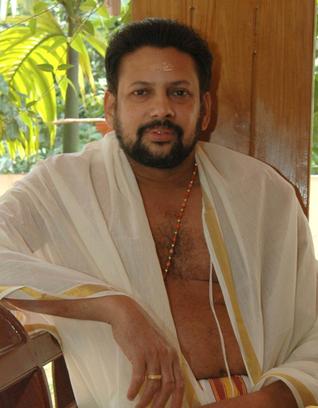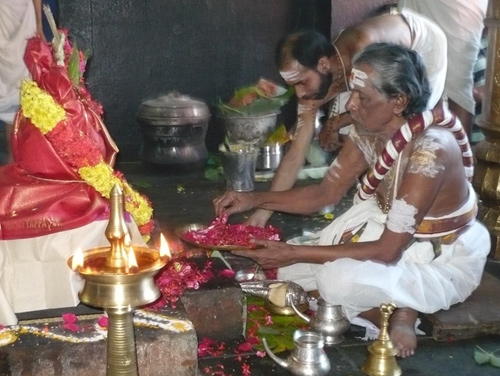Thazhamon Family
Seat of the Thazhamon family of tantris is Chengannur in central Kerala. They are the traditional priests of Sabarimala temple. Apart from Sabarimala, the family presides over the poojas at Aryankavu, Achankovil and Kulathupuzha. The installation of idols at these temples was also performed by Thazhamon priests and this gives them a paternal
While the Brahmin who walked over the water was called Tharananelloor ( Tharanam means to cross), the other priest was called Thazhamon ( the one who walked on the sand below the river). The sage also bestowed the tittle Kandararu to the Thazhamon family. The present idol at the Sabarimala was installed by late Kandararu Sankararu.
 The earlier idol which was destroyed in n a fire was installed by Kandararu Prabhakararu. Eldest among the present generation of priests at Thazhamon is Kandararu Neelakantararu.. The others are his a brother Kandararu Maheswararu, and son of his late a brother Kandararu Krishnararu, Kandararu a Rajeevararu.Each priest officiates the tI proceedings once in three years. The maie child F in the family is initiated into the tantric world soon after his upanayanam at the age of five. s' The boy observes three years of s brahmacharyam and wears blades of the dharbha grass on his body. This period is followed by samavarthana kaalam. During this time the boy is taught vedas, mantras and other rituals. After samavarathanam, he will have to observe penance for a year. This is followed by a pilgrimage to Sabarimala as a junior tantri. He begins perrfoming poojas alone at the age of 18. Before this he would've obtained the 'Rahasya upadesham' (secret and sacred advice which is given to the member of family only at a particular age).Even the women of the family have to follow certain practices: From the third month of pregnancy they have to start consuming medicated ghee. There are several other traditions to be followed in the successive months.
The earlier idol which was destroyed in n a fire was installed by Kandararu Prabhakararu. Eldest among the present generation of priests at Thazhamon is Kandararu Neelakantararu.. The others are his a brother Kandararu Maheswararu, and son of his late a brother Kandararu Krishnararu, Kandararu a Rajeevararu.Each priest officiates the tI proceedings once in three years. The maie child F in the family is initiated into the tantric world soon after his upanayanam at the age of five. s' The boy observes three years of s brahmacharyam and wears blades of the dharbha grass on his body. This period is followed by samavarthana kaalam. During this time the boy is taught vedas, mantras and other rituals. After samavarathanam, he will have to observe penance for a year. This is followed by a pilgrimage to Sabarimala as a junior tantri. He begins perrfoming poojas alone at the age of 18. Before this he would've obtained the 'Rahasya upadesham' (secret and sacred advice which is given to the member of family only at a particular age).Even the women of the family have to follow certain practices: From the third month of pregnancy they have to start consuming medicated ghee. There are several other traditions to be followed in the successive months.

While the Brahmin who walked over the water was called Tharananelloor ( Tharanam means to cross), the other priest was called Thazhamon ( the one who walked on the sand below the river). The sage also bestowed the tittle Kandararu to the Thazhamon family. The present idol at the Sabarimala was installed by late Kandararu Sankararu.
 The earlier idol which was destroyed in n a fire was installed by Kandararu Prabhakararu. Eldest among the present generation of priests at Thazhamon is Kandararu Neelakantararu.. The others are his a brother Kandararu Maheswararu, and son of his late a brother Kandararu Krishnararu, Kandararu a Rajeevararu.Each priest officiates the tI proceedings once in three years. The maie child F in the family is initiated into the tantric world soon after his upanayanam at the age of five. s' The boy observes three years of s brahmacharyam and wears blades of the dharbha grass on his body. This period is followed by samavarthana kaalam. During this time the boy is taught vedas, mantras and other rituals. After samavarathanam, he will have to observe penance for a year. This is followed by a pilgrimage to Sabarimala as a junior tantri. He begins perrfoming poojas alone at the age of 18. Before this he would've obtained the 'Rahasya upadesham' (secret and sacred advice which is given to the member of family only at a particular age).Even the women of the family have to follow certain practices: From the third month of pregnancy they have to start consuming medicated ghee. There are several other traditions to be followed in the successive months.
The earlier idol which was destroyed in n a fire was installed by Kandararu Prabhakararu. Eldest among the present generation of priests at Thazhamon is Kandararu Neelakantararu.. The others are his a brother Kandararu Maheswararu, and son of his late a brother Kandararu Krishnararu, Kandararu a Rajeevararu.Each priest officiates the tI proceedings once in three years. The maie child F in the family is initiated into the tantric world soon after his upanayanam at the age of five. s' The boy observes three years of s brahmacharyam and wears blades of the dharbha grass on his body. This period is followed by samavarthana kaalam. During this time the boy is taught vedas, mantras and other rituals. After samavarathanam, he will have to observe penance for a year. This is followed by a pilgrimage to Sabarimala as a junior tantri. He begins perrfoming poojas alone at the age of 18. Before this he would've obtained the 'Rahasya upadesham' (secret and sacred advice which is given to the member of family only at a particular age).Even the women of the family have to follow certain practices: From the third month of pregnancy they have to start consuming medicated ghee. There are several other traditions to be followed in the successive months.

